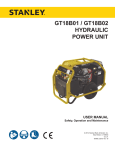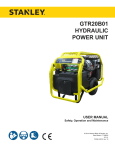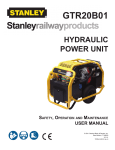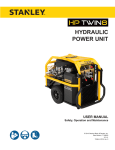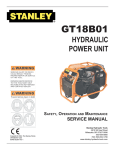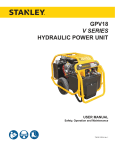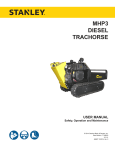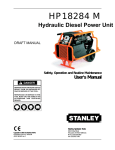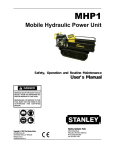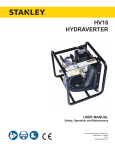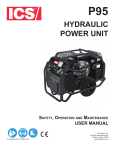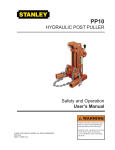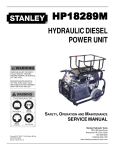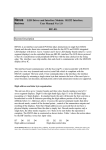Download GT23 User Manual 10-2014 V-7
Transcript
GT23 HYDRAULIC POWER UNIT USER’S MANUAL SAFETY, OPERATION AND MAINTENANCE © 2014 Stanley Black & Decker, Inc. New Britain, CT 06053 U.S.A. 69405 10/2014 Ver. 7 NOTES 2 GT23 User Manual TABLE OF CONTENTS SAFETY SYMBOLS......................................................................................................................................................................... 4 SAFETY PRECAUTIONS................................................................................................................................................................ 5 TOOL STICKERS & TAGS.............................................................................................................................................................. 6 HYDRAULIC HOSE REQUIREMENTS........................................................................................................................................... 7 HOSE SAFETY TAGS..................................................................................................................................................................... 7 HOSE RECOMMENDATIONS......................................................................................................................................................... 8 HTMA REQUIREMENTS................................................................................................................................................................. 9 OPERATION.................................................................................................................................................................................. 10 PREPARATION FOR USE............................................................................................................................................................. 10 CONTROLS................................................................................................................................................................................... 12 STARTUP....................................................................................................................................................................................... 12 FOR 8 GPM OPERATION............................................................................................................................................................. 12 FOR 12 GPM OPERATION........................................................................................................................................................... 12 COLD WEATHER STARTUP......................................................................................................................................................... 13 SHUTDOWN.................................................................................................................................................................................. 13 ROUTINE MAINTENANCE............................................................................................................................................................ 14 STORAGE..................................................................................................................................................................................... 14 PROGRAMMABLE CONTROLLER............................................................................................................................................... 15 TROUBLESHOOTING GUIDELINES............................................................................................................................................ 15 FAULT CODES.............................................................................................................................................................................. 16 TESTING & TROUBLESHOOTING............................................................................................................................................... 17 TESTING THE HYDRAULIC CIRCUIT.......................................................................................................................................... 17 TESTING THE 8 GPM HTMA TYPE II CIRCUIT........................................................................................................................... 17 OR THE 12 GPM TYPE III CIRCUIT............................................................................................................................................. 17 TROUBLESHOOTING................................................................................................................................................................... 18 SPECIFICATIONS......................................................................................................................................................................... 19 BRIGGS ENGINE ASSEMBLY...................................................................................................................................................... 20 BRIGGS ENGINE PARTS LIST..................................................................................................................................................... 21 FUEL TANK & CAP........................................................................................................................................................................ 22 FRAME PARTS.............................................................................................................................................................................. 23 HOSES, FITTINGS & CLAMPS..................................................................................................................................................... 24 MAIN POWER UNIT WIRING HARNESS..................................................................................................................................... 25 IMPORTANT To fill out a Product Warranty Validation form, and for information on your warranty, visit Stanleyhydraulics.com and select the Company tab, Warranty. (NOTE: The warranty Validation record must be submitted to validate the warranty). SERVICING: This manual contains safety, operation, and routine maintenance instructions. Stanley recommends that servicing of hydraulic tools, other than routine maintenance, must be performed by an authorized and certified dealer. Please read the following warning. WARNING SERIOUS INJURY OR DEATH COULD RESULT FROM THE IMPROPER REPAIR OR SERVICE OF THIS TOOL. REPAIRS AND / OR SERVICE TO THIS TOOL MUST ONLY BE DONE BY AN AUTHORIZED AND CERTIFIED DEALER. For the nearest authorized and certified dealer, call Stanley Hydraulic Tools at the number listed on the back of this manual and ask for a Customer Service Representative. GT23 User Manual 3 SAFETY SYMBOLS Safety symbols and signal words, as shown below, are used to emphasize all operator, maintenance and repair actions which, if not strictly followed, could result in a life-threatening situation, bodily injury or damage to equipment. This is the safety alert symbol. It is used to alert you to potential personal injury hazards. Obey all safety messages that follow this symbol to avoid possible injury or death. DANGER This safety alert and signal word indicate an imminently hazardous situation which, if not avoided, will result in death or serious injury. WARNING This safety alert and signal word indicate a potentially hazardous situation which, if not avoided, could result in death or serious injury. CAUTION This safety alert and signal word indicate a potentially hazardous situation which, if not avoided, could result in death or serious injury. CAUTION This signal word indicates a potentially hazardous situation which, if not avoided, may result in property damage. NOTICE This signal word indicates a situation which, if not avoided, will result in damage to the equipment. IMPORTANT This signal word indicates a situation which, if not avoided, may result in damage to the equipment. Always observe safety symbols. They are included for your safety and for the protection of the tool. LOCAL SAFETY REGULATIONS Enter any local safety regulations here. Keep these instructions in an area accessible to the operator and maintenance personnel. 4 GT23 User Manual SAFETY PRECAUTIONS Tool operators and maintenance personnel must always comply with the safety precautions given in this manual and on the stickers and tags attached to the equipment. These safety precautions are given for your safety. Review them carefully before operating the tool and before performing general maintenance or repairs. Supervising personnel should develop additional precautions relating to the specific work area and local safety regulations. If so, place the added precautions in the space provided on page 4. In addition to this manual, read and understand safety and operating instructions in the Engine Operation Manual furnished with the power unit. The Hydraulic Power Unit will provide safe and dependable service if operated in accordance with the instructions given in this manual. Read and understand this manual and any stickers and tags attached to the Power Unit. Failure to do so could result in personal injury or equipment damage. • Operator must start in a work area without bystanders. The operator must be familiar with all prohibited work areas such as excessive slopes and dangerous terrain conditions. • Establish a training program for all operators to ensure safe operation. • Do not operate the power unit unless thoroughly trained or under the supervision of an instructor. • Always wear safety equipment such as goggles, ear, head protection, and safety shoes at all times when operating the power unit and a hydraulic tool. • Do not inspect or clean the power unit while it is running. Accidental engagement of the unit can cause serious injury. • Always use hoses and fittings rated at 2500 psi/172 bar with a 4 to 1 safety factor. Be sure all hose connections are tight. • Be sure all hoses are connected for correct flow direction to and from the tool being used. • Do not inspect hoses and fittings for leaks by using bare hands. “Pin-hole” leaks can penetrate the skin. • NEVER OPERATE THE POWER UNIT IN A CLOSED SPACE. Inhalation of engine exhaust can be fatal. • Do not operate a damaged, improperly adjusted power unit. • Never wear loose clothing that can get entangled in the working parts of the power unit. • Keep all parts of your body away from the working parts of the power unit. • Keep clear of hot engine exhaust. • Do not add fuel to the power unit while the power unit is running or is still hot. • Do not operate the power unit if gasoline odor is present. • Do not use flammable solvents around the power unit engine. • Do not operate the power unit within 3.3 ft/1 m of buildings, obstructions or flammable objects. • Do not reverse tool rotation direction by changing fluid flow direction. • Allow power unit engine to cool before storing in an enclosed space. • Always keep critical tool markings, such as labels and warning stickers legible. • To avoid personal injury or equipment damage, all tool repair, maintenance and service must only be performed by authorized and properly trained personnel. GT23 User Manual 5 DASH DECALS Stanley Dash Sticker 62302 Single Circuit Sticker 68595 6 GT23 User Manual HYDRAULIC HOSE REQUIREMENTS HOSE TYPES The rated working pressure of the hydraulic hose must be equal to or higher than the relief valve setting on the hydraulic system.There are three types of hydraulic hose that meet this requirement and are authorized for use with Stanley Hydraulic Tools. They are: Certified non-conductive - constructed of thermoplastic or synthetic rubber inner tube, synthetic fiber braid reinforcement, and weather resistant thermoplastic or synthetic rubber cover. Hose labeled certified nonconductive is the only hose authorized for use near electrical conductors. Wire-braided (conductive) - constructed of synthetic rubber inner tube, single or double wire braid reinforcement, and weather resistant synthetic rubber cover. This hose is conductive and must never be used near electrical conductors. Fabric-braided (not certified or labeled non-conductive) - constucted of thermoplastic or synthetic rubber inner tube, synthetic fiber braid reinforcement, and weather resistant thermoplastic or synthetic rubber cover. This hose is not certified non-conductive and must never be used near electrical conductors. HOSE SAFETY TAGS To help ensure your safety, the following DANGER tags are attached to all hose purchased from Stanley Hydraulic Tools. DO NOT REMOVE THESE TAGS. If the information on a tag is illegible because of wear or damage, replace the tag immediately. A new tag may be obtained from your Stanley Distributor. D A N G E R D A N G E R 1 FAILURE TO USE HYDRAULIC HOSE LABELED AND CERTIFIED AS NON-CONDUCTIVE WHEN USING HYDRAULIC TOOLS ON OR NEAR ELECTRIC LINES MAYRESULT IN DEATH OR SERIOUS INJURY. FOR PROPER AND SAFE OPERATION MAKE SURE THAT YOU HAVE BEEN PROPERLY TRAINED IN CORRECT PROCEDURES REQUIRED FOR WORK ON OR AROUND ELECTRIC LINES. 2. BEFORE USING HYDRAULIC HOSE LABELED AND CERTIFIED AS NON-CONDUCTIVE ON OR NEAR ELECTRIC LINES. WIPE THE ENTIRE LENGTH OF THE HOSE AND FITTING WITH A CLEAN DRY ABSORBENT CLOTH TO REMOVE DIRT AND MOSISTURE AND TEST HOSE FOR MAXIMUM ALLOWABLE CURRENT LEAKAGE IN ACCORDANCE WITH SAFETY DEPARTMENT INSTRUCTIONS. 3. DO NOT EXCEED HOSE WORKING PRESSURE OR ABUSE HOSE. IMPROPER USE OR HANDLING OF HOSE COULD RESULT IN BURST OR OTHER HOSE FAILURE. KEEP HOSE AS FAR AWAY AS POSSIBLE FROM BODY AND DO NOT PERMIT DIRECT CONTACT DURING USE. CONTACT AT THE BURST CAN CAUSE BODILY INJECTION AND SEVERE PERSONAL INJURY. 4. HANDLE AND ROUTE HOSE CAREFULLY TO AVOID KINKING, ABRASION, CUTTING, OR CONTACT WITH HIGH TEMPERATURE SURFACES. DO NOT USE IF KINKED. DO NOT USE HOSE TO PULL OR LIFT TOOLS, POWER UNITS, ETC. 5. CHECK ENTIRE HOSE FOR CUTS CRACKS LEAKS ABRASIONS, BULGES, OR DAMAGE TO COUPLINGS IF ANY OF THESE CONDITIONS EXIST, REPLACE THE HOSE IMMEDIATELY. NEVER USE TAPE OR ANY DEVICE TO ATTEMPT TO MEND THE HOSE. 6. AFTER EACH USE STORE IN A CLEAN DRY AREA. SEE OTHER SIDE 3 DO NOT REMOVE THIS TAG DO NOT REMOVE THIS TAG THE TAG SHOWN BELOW IS ATTACHED TO “CERTIFIED NON-CONDUCTIVE” HOSE SEE OTHER SIDE SIDE 1 (shown smaller than actual size) SIDE 2 D A N G E R 1 DO NOT USE THIS HYDRAULIC HOSE ON OR NEAR ELECTRIC LINES. THIS HOSE IS NOT LABELED OR CERTIFIED AS NON-CONDUCTIVE. USING THIS HOSE ON OR NEAR ELECTRICAL LINES MAY RESULT IN DEATH OR SERIOUS INJURY. 2. FOR PROPER AND SAFE OPERATION MAKE SURE THAT YOU HAVE BEEN PROPERLY TRAINED IN CORRECT PROCEDURES REQUIRED FOR WORK ON OR AROUND ELECTRIC LINES. D A N G E R 5. CHECK ENTIRE HOSE FOR CUTS CRACKS LEAKS ABRASIONS, BULGES, OR DAMAGE TO COUPLINGS IF ANY OF THESE CONDITIONS EXIST, REPLACE THE HOSE IMMEDIATELY. NEVER USE TAPE OR ANY DEVICE TO ATTEMPT TO MEND THE HOSE. 6. AFTER EACH USE STORE IN A CLEAN DRY AREA. 3. DO NOT EXCEED HOSE WORKING PRESSURE OR ABUSE HOSE. IMPROPER USE OR HANDLING OF HOSE COULD RESULT IN BURST OR OTHER HOSE FAILURE. KEEP HOSE AS FAR AWAY AS POSSIBLE FROM BODY AND DO NOT PERMIT DIRECT CONTACT DURING USE. CONTACT AT THE BURST CAN CAUSE BODILY INJECTION AND SEVERE PERSONAL INJURY. 4. HANDLE AND ROUTE HOSE CAREFULLY TO AVOID KINKING, CUTTING, OR CONTACT WITH HIGH TEMPERATURE SURFACES. DO NOT USE IF KINKED. DO NOT USE HOSE TO PULL OR LIFT TOOLS, POWER UNITS, ETC. DO NOT REMOVE THIS TAG DO NOT REMOVE THIS TAG THE TAG SHOWN BELOW IS ATTACHED TO “CONDUCTIVE” HOSE. SEE OTHER SIDE SIDE 1 (shown smaller than actual size) SIDE 2 GT23 User Manual 7 8 GT23 User Manual All hydraulic hose must meet or exceed specifications as set forth by SAE J517. All hydraulic hose must have at least a rated minimum working pressure equal to the maximum hydraulic system relief valve setting. This chart is intended to be used for hydraulic tool applications only based on Stanley Hydraulic Tools tool operating requirements and should not be used for any other applications. The chart to the right shows recommended minimum hose diameters for various hose lengths based on gallons per minute (gpm)/liters per minute (lpm). These recommendations are intended to keep return line pressure (back pressure) to a minimum acceptable level to ensure maximum tool performance. Tool to Hydraulic Circuit Hose Recommendations 38-49 38-49 10-13 10-13 up to 10 up to 3 FLOW >>> RETURN <<< FLOW PRESSURE 26-100 up to 25 100-200 51-100 up to 50 100-300 51-100 up to 50 26-100 up to 25 8-30 up to 8 30-60 15-30 up to 15 30-90 15-30 up to 15 7.5-30 up to 7.5 Typical Hose Connections 49-60 49-60 19-40 5-10.5 13-16 19-40 5-10.5 38-49 19-40 5-10.5 10-13 15-23 15-23 4-6 13-16 MM Inside Diameter INCH USE (Press/Return) PSI 3/8 10 Both 2250 3/8 10 19 25.4 16 19 19 25.4 1 5/8 3/4 3/4 1 19 3/4 3/4 16 16 5/8 19 5/8 3/4 16 16 5/8 13 13 5/8 1/2 1/2 Both Return Pressure Return Pressure Return Pressure Return Pressure Both Return Pressure Both Both Both 2500 2500 2500 2500 2500 2500 2500 2500 2500 2500 2500 2500 2500 2500 2500 175 175 175 175 175 175 175 175 175 175 175 175 175 175 175 155 BAR Min. Working Pressure Certified Non-Conductive Hose - Fiber Braid - for Utility Bucket Trucks METERS Hose Lengths FEET Conductive Hose - Wire Braid or Fiber Braid -DO NOT USE NEAR ELECTRICAL CONDUCTORS 15-34 4-6 4-9 LPM Oil Flow GPM HOSE RECOMMENDATIONS HTMA / EHTMA REQUIREMENTS HTMA / EHTMA REQUIREMENTS HTMA HYDRAULIC SYSTEM REQUIREMENTS TYPE I Nominal Operating Pressure (at the power supply outlet) 4-6 gpm (15-23 lpm) 1500 psi (103 bar) TOOL TYPE TYPE II TYPE RR 7-9 gpm (26-34 lpm) 1500 psi (103 bar) 9-10.5 gpm (34-40 lpm) 1500 psi (103 bar) System relief valve setting (at the power supply outlet) 2100-2250 psi (145-155 bar) 2100-2250 psi (145-155 bar) 2200-2300 psi (152-159 bar) 2100-2250 psi (145-155 bar) Maximum back pressure (at tool end of the return hose) 250 psi (17 bar) 250 psi (17 bar) 250 psi (17 bar) 250 psi (17 bar) Measured at a max. fluid viscosity of: (at min. operating temperature) 400 ssu* 400 ssu* 400 ssu* 400 ssu* (82 centistokes) (82 centistokes) (82 centistokes) (82 centistokes) Temperature: Sufficient heat rejection capacity to limit max. fluid temperature to: (at max. expected ambient temperature) 140° F (60° C) Flow Range 140° F (60° C) 140° F (60° C) TYPE III 11-13 gpm (42-49 lpm) 1500 psi (103 bar) 140° F (60° C) 3 hp 5 hp 6 hp 7 hp Min. cooling capacity at a temperature (2.24 kW) (3.73 kW) (5.22 kW) (4.47 kW) difference of between ambient and fluid 40° F 40° F 40° F 40° F temps (22° C) (22° C) (22° C) (22° C) NOTE: Do not operate the tool at oil temperatures above 140° F (60° C). Operation at higher temperatures can cause operator discomfort at the tool. Filter Min. full-flow filtration Sized for flow of at least: (For cold temp. startup and max. dirt-holding capacity) 25 microns 30 gpm (114 lpm) Hydraulic fluid Petroleum based (premium grade, anti-wear, non-conductive) Viscosity (at min. and max. operating temps) 100-400 ssu* 25 microns 30 gpm (114 lpm) 25 microns 30 gpm (114 lpm) 100-400 ssu* 100-400 ssu* (20-82 centistokes) 25 microns 30 gpm (114 lpm) 100-400 ssu* NOTE: When choosing hydraulic fluid, the expected oil temperature extremes that will be experienced in service determine the most suitable temperature viscosity characteristics. Hydraulic fluids with a viscosity index over 140 will meet the requirements over a wide range of operating temperatures. *SSU = Saybolt Seconds Universal EHTMA HYDRAULIC SYSTEM REQUIREMENTS CLASSIFICATION B C D Nominal Operating Pressure (at the power supply outlet) 3.5-4.3 gpm (13.5-16.5 lpm) 1870 psi (129 bar) 4.7-5.8 gpm (18-22 lpm) 1500 psi (103 bar) 7.1-8.7 gpm (27-33 lpm) 1500 psi (103 bar) 9.5-11.6 gpm (36-44 lpm) 1500 psi (103 bar) 11.8-14.5 gpm (45-55 lpm) 1500 psi (103 bar) System relief valve setting (at the power supply outlet) 2495 psi (172 bar) 2000 psi (138 bar) 2000 psi (138 bar) 2000 psi (138 bar) 2000 psi (138 bar) Flow Range NOTE: These are general hydraulic system requirements. See tool specification page for tool specific requirements GT23 User Manual 9 OPERATION PREPARATION FOR USE Do not operate the power unit until you have read the engine operating and maintenance instructions manual furnished with the unit. 1. ENGINE CRANKCASE OIL LEVEL Always check the oil level before starting the engine. Make sure the oil level is at the FULL MARK on the dipstick. Do not overfill. Use detergent oil classified "For Service SE, SF, SG" as specified in the engine operating and maintenance manual. See engine manual for oil viscosity grade. 5. HYDRAULIC CONNECTIONS The recommended hose length is 25 ft/8 m with a 1/2 inch/12.7 mm inside diameter. The hoses must have a working pressure rating of at least 2500 psi/175 bar. Each hose end must have male thread ends compatible with H.T.M.A. (HYDRAULIC TOOL MANUFACTURERS ASSOCIATION) quick disconnect fittings (NPT type threads). (See Page 8.) 2. SPARK PLUG On power units equipped with Briggs & Stratton Engines, ONLY Champion RC12YC or equivalent can be used. Incorrect type spark plugs can produce radio frequency interference that will corrupt and damage the controller. Failure to use the correct spark plug could result in a warranty that will not be considered. Figure 1. Panel Control Valve Facing the panel control valve, the bottom male quick disconnect fitting is the PRESSURE FLUID OUT fitting. The top female quick disconnect fitting is the RETURN FLUID IN fitting. 3. ENGINE FUEL LEVEL Check the fuel level. If low, fill with un-leaded gasoline with a minimum of 85 octane. 4. HYDRAULIC FLUID RECOMMENDED HYDRAULIC OILS Below is a list of recommended oils by brand. Brand Biodegradable Description CITGO No Hydurance AW32 AMS Oil No HVH 32 Exxon Mobil No Univis HVI26* Exxon Mobil No DTE 10 Excel Shell No S2 V 32 Chevron No Rando HDZ 32 Conoco Phillips No Unax AW-WR-32 Clarion (CITGO) Yes Green Bio 32 Exxon Mobil Yes EAL 224H Chevron Yes Clarity AW32 Terresolve Yes Envirologic 132 Shell Yes Naturelle HF-E-32 * Recommended for extreme cold temperatures 10 GT23 User Manual QUICK DISCONNECT COUPLERS H.T.M.A. approved quick disconnect couplings are installed to hydraulic hoses so that the direction of oil flow is always from the male to the female quick disconnect as shown on page 8. Quick disconnect couplings and hose fittings are selected so that additional fittings such as reducer or adapter fittings are not required. If adapter fittings are used, they must be approved steel hydraulic fittings meeting a minimum operating pressure rating of 2500 psi/172 bar. Do not use galvanized pipe fittings or black pipe fittings. Use thread tape or pipe joint compound when installing quick disconnect couplings to hose or tool fittings. Follow the instructions furnished with the selected thread sealant. DO NOT OVERTIGHTEN THE FITTINGS. OPERATION 6. BATTERY The supplied 12 Volt DC battery is a non-spillable, maintenance-free battery and is fully charged. Make sure the battery cables are tight and charging circuit functions are operating properly. Do not charge the battery with a standard automotive battery charger. This type of charger produces a charging amperage higher than 2 amps. Charging the battery at higher than 2 amps will damage the battery. If the engine runs out of gas or dies during operation and the ignition switch is left in the ON or RUN position, this could drain the battery. Make sure the ignition switch is returned to the OFF position. GT23 User Manual 11 OPERATION CONTROLS This unit is equipped with an advanced proportional engine control system. It provides a means of controlling engine speed by adjusting the fuel control lever with an actuator. The Power Unit provides one circuit, with an oil flow of 8 gpm/30 lpm up to 2000 psi/140 bar or 12 gpm/45 lpm up to 2000 psi/140 bar with a factory-programmed electronic governed engine throttle. THROTTLE CONTROL SWITCH throttle control switch flow selector switch IGNITION SWITCH FLOW SELECTOR SWITCH Note: It may be necessary to reset the Controller. At times it may be neccessary to reset the controller. This could happen if a fault occurs in the controller. For example, excessive engine speed. If a fault does occur the power unit will return to an idle and the operator will have no control of the unit. To reset the controller, simply turn off the power unit and restart it. STARTUP Before starting the engine make sure the flow selector switch is in the OFF position. Note: The power unit will not start if the flow control switch is not in the "OFF" position. ignition switch Figure 3. Panel Control Valve One hydraulic tool can be connected to the tool circuit. The circuit is activated by turning the flow control switch to either the 8 gpm/30 lpm or 12 gpm/45 lpm setting. THROTTLE CONTROL The throttle control permits the operator to select one of 2 operating modes after the engine has warmed up. When starting the engine, make sure the flow selector switch is in the OFF position. The throttle control switch can be set in either the AUTO-IDLE-ON or AUTO-IDLE-OFF positions. AUTO-ON When the throttle control switch is in the "AUTO-ON" position, the oil flow is regulated automatically when the trigger on the tool activated. When the tool is not being used the engine will return to idle automatically, after a 10 second delay. This setting will produce 8 gpm/30 lpm or 12 gpm/45 lpm depending on which postion the operator has selected with the flow selector switch. AUTO-OFF When the throttle control switch is in the "AUTO-OFF" position, the engine speed is held to maintain 8 gpm/30 lpm or 12 gpm/45 lpm depending on which position the operator has selected with the flow selector switch. When a tool is not being used the engine will not return to idle until either the flow selector switch is turned to the OFF position or the throttle control switch is turned to AUTO-ON. Pull choke knob out and move the Throttle Control Switch to the auto-idle-off or the auto-idle-on position, whichever mode of operation the operator prefers. Ensure the flow selector switch is in the OFF position. Turn the Ignition Switch to the START position. After the engine starts, release the switch. Gradually push in the choke knob as the engine begins to idle smoothly. Allow the engine to warm up. Connect hoses and the tool as desrcribed on page 8 and 10. FOR 8 GPM OPERATION For 8 gpm operation, select mode of operation with the Throttle Control switch, either auto-idle-on or the auto-idleoff position. Move the flow selector switch to the 8 gpm position. When finished operating the tool, move the flow selector switch to the OFF position. FOR 12 GPM OPERATION For 12 gpm operation, select mode of operation with the Throttle Control Switch, either auto-idle-on or the auto-idleoff position. Move the flow selector switch to the 12 gpm position. When finished operating the tool, move the flow selector switch to the OFF position. 12 GT23 User Manual OPERATION COLD WEATHER STARTUP 1. Use the procedures described under "STARTUP" and then follow the procedure below. 2. Hydraulic fluids are thicker in cold weather. Therefore, it is recommended that the engine be run at low idle long enough to bring the fluid temperature up to a minimum of 50°F/10°C. 3. If the tools and tool hoses are cold, it is recommended to allow hydraulic fluid to circulate through the tool hoses until warm before using the tool. SHUTDOWN 1. Ensure the flow selector switch in the OFF position (center position). 2. Unless already at idle the power unit should return to idle. This may take a few seconds for the unit to react due to a built-in program delay. 3. Allow the engine to idle for approximately one minute and move the Ignition Switch to the OFF position. GT23 User Manual 13 ROUTINE MAINTENANCE ENGINE MAINTENANCE STORAGE Follow the maintenance schedule and general maintenance instructions in the engine maintenance and operation manual furnished with the power unit. • Clean the unit thoroughly before storage. Do not use water pressure. HYDRAULIC SYSTEM MAINTENANCE • Always store the unit in a clean and dry facility. • Check hydraulic fluid level daily. Add fluid per specifications in this manual. (See "HYDRAULIC FLUID" under the section titled "OPERATION". • If the unit will be stored for a prolonged period (over 30 days), add a fuel additive to the fuel tank to prevent the fuel from gumming. Run engine for a short period to circulate the additive. • Remove condensed moisture from the hydraulic fluid by pumping the hydraulic fluid into a 5 gal/20 l container through the pressure hose. Make sure the engine is at idle when performing this procedure. When the hydraulic reservoir is empty turn the engine off immediately. • Allow the fluid to sit long enough for the water to settle to the bottom of the container. Slowly pour the fluid back into the hydraulic tank, avoiding the water at the bottom of the container. • Each day, check hydraulic lines and fittings for leaks, kinks, etc. Do not use your hand to perform this check. • Change the hydraulic filter element every 200 hours of operation. Change more often if cold, moist or dusty conditions exist. • Check oil cooler for debris. Remove debris with air pressure. SPARK PLUGS On power units equipped with Briggs & Stratton Engines, ONLY Champion RC12YC or equivalent can be used. Incorrect type spark plugs can produce radio frequency interference that will corrupt and damage the controller. Failure to use the correct spark plug could result in a warranty that will not be considered. 14 GT23 User Manual • Replace crankcase oil with new oil. • Remove spark plugs and pour approximately 1 ounce (30 ml) of engine oil into each cylinder. Replace spark plugs and crank the engine slowly to distribute the oil. • Check hydraulic reservoir for water. If water is found, change the oil and circulate it through the tool hose and tool. • Disconnect tool hoses. PROGRAMMABLE CONTROLLER The Stanley programmable controller is an electronic engine governor that provides a means of controlling and limiting engine speed by adjusting the fuel control lever with a proportional actuator. The controller is factory programmable and has no manual adjustments. A flashing LED indicates the fault condition 1. Disconnect red wires from the control module to actuator. 2. Attach jumper wires from battery to the RED wires to actuator. 3. Actuator should move throttle lever to wide open position. a. If actuator does not move it is defective. (Replace). b. If actuator moves throttle to wide-open position, the module is defective. (Replace). Note: Before replacing the actuator verify signal inputs to module (see Stanley Electrical Trouble shooting guide "TechHELP # 032807. A copy of the TechHELP can be obtained from the Stanley Hydraulic Tools web site at www.stanley-hydraulic-tools. com/support%20page.htm or contact a Customer Service Representative at (503) 659-5660. FAULT CODES CALIBRATION Calibration and programming can only be done by the factory. TROUBLESHOOTING GUIDELINES Please follow the checklist below to troubleshoot your Stanley controller. 1. Check battery voltage for stability and correct value. The LED will turn on for one second when the controller is first powered up. 2. Check the actuator linkage for binding and backlash. CHECKING PERFORMANCE CONTROL (ELECTRONIC GOVERNOR-STATIC CHECK) To determine whether a governor problem is being caused by the actuator or the control module, perform the following static check exactly in order shown. The Stanley controller is capable of identifying certain fault conditions and alerting the user to them. A flashing LED indicates the fault conditions. The current fault code list is shown on the following page. Please note the following: 1. When power is first applied to the controller, the LED will flash just once for one second to indicate that the LED is working. 2. If there are multiple faults, the LED will flash them all in sequence. Count the flash codes to determine the fault conditions or connect the Calibration Tool to observe the fault conditions. (Use the “Display Faults” option under the Monitor Menu.) 3. If there are no faults, the LED will flash once at reset and from then on indicate the detection of engine speed. A continuous ON LED indicates that a valid engine speed is being sensed. 4. The controller will attempt to shut down for some faults and will not permit starting after reset with faults 1, 5 and 8. A pair of jumper wires and a known good 12-volt battery is required. GT23 User Manual 15 FAULT CODES FLASHENGINE CODE FAULT SHUTDOWN CORRECTIVE ACTION 1 Unit not calibrated yes Have engine serviced by an Authorized Stanley Dealer. 2 Engine speed excessive yes Have engine serviced by an Authorized Stanley Dealer. 3 Engine speed unusually low yes Have engine serviced by an Authorized Stanley Dealer. 4 Engine shutdown due to engine yes protection input Have engine serviced by an Authorized Stanley Dealer. 5 Factory settings lost yes Have engine serviced by an Authorized Stanley Dealer. 6 External pot out-of-range no Have engine serviced by an Authorized Stanley Dealer. 7 Accelerator position / idle switch conflict no Have engine serviced by an Authorized Stanley Dealer. Controller unit failed yes Have engine serviced by an Authorized Stanley Dealer. 8 9 Limiting excessive no actuator current Have engine serviced by an Authorized Stanley Dealer. 10 Engine speed input no signal missing (Active only in Auto crank mode). Check speed sensor wiring. Check starter motor. 11 Auto crank unable to start engine Check fuel. no 12 Auxiliary output is shorted no Check the lamp or relay hooked to the output. If fault is still present, have engine serviced by an authorized Stanley Dealer. 13 Auxiliary output #2 is shorted no Check the lamp or relay hooked to the output. If fault is still present, have engine serviced by an authorized Stanley dealer. 14 Check actuator wiring and actuator resistance. Resistance should be less than 10 ohms. Actuator disconnected or no open circuit 16 GT23 User Manual TESTING THE HYDRAULIC CIRCUIT GENERAL Tests and adjustments should be performed periodically to ensure the power unit is operating at maximum efficiency. Stanley Circuit Tester is recommended. This tester can be used to isolate problems in both the engine and hydraulic system prior to any power unit disassembly. TESTING THE HYDRAULIC CIRCUIT The following tests can be performed to ensure that the hydraulic pump is supplying the correct flow and pressure and that the system relief valve is operating properly. During these tests, make sure the engine is warm and operating smoothly. If test results are not as specified, refer to the troubleshooting table in this section for possible causes. pressure". At the "cracking pressure," the flow rate should start to drop because the relief valve is allowing fluid to bypass to the hydraulic reservoir. The "cracking pressure" is preset at the factory and if it is not within the above range, the relief valve must be re-set as follows: a. The relief valve is located on the right side of the unit just behind the dash panel. It protrudes out from the manifold assembly. Use a open end or box end wrench to loosen the nut on the relief valve. b. Use an Allen wrench to adjust the relief valve. Turn clockwise to raise the pressure and counterclockwise to reduce the pressure. c. Tighten the nut and retest. TESTING THE 8 GPM HTMA TYPE II CIRCUIT OR THE 12 GPM TYPE III CIRCUIT To test the circuit, proceed as follows: 1. Set the flow selector switch to the OFF (center) position. 2. Set the throttle control switch to AUTO-OFF position. 3. Connect the Stanley Circuit Tester across two hose ends (where the tool would normally be connected). 4. Fully open the tester restrictor valve (counterclockwise). 5. Start the engine and allow it to run until warm. 6. Switch the flow selector switch to 8 or 12 gpm depending on which flow you are testing. 7. With the engine at the programed speed, the test flow gauge should read 7-9 gpm/26.5-34 lpm or 11-13 gpm/41.6-49 lpm. 8. Slowly turn the restrictor valve clockwise while watching the pressure gauge. The flow rate should stay at 7-9 gpm/26.5-34 lpm or 11-13 gpm/41.6-49 lpm as the pressure gauge reaches 2100-2200 psi/148-155 bar. 9. At 2100-2200 psi/148-155 bar, the relief valve should begin to open. The pressure at which the relief valve just begins to open is commonly referred to as the "cracking GT23 User Manual 17 TROUBLESHOOTING PROBLEMCAUSEREMEDY Engine will not start. Flow selector switch not in the OFF position. Battery not connected. Make sure the flow selector switch is in the OFF position when starting. Weak battery. Test battery, charge or replace. No fuel. Add Fuel. Fuel filter plugged. Replace fuel filter. Attach battery cables, check wires. Defective spark plugs. Remove plugs, check gap, clean or replace. Fluid blowing out of fluid reservoir vent. Hydraulic tank overfilled. Correct the fluid level. Pump suction leak. Check suction connections. Tighten if necessary. Hydraulic tool won't operate. Flow selector switch not switched ON. Check that the flow selector switch is set to 8 or 12 gpm. Incorrect hose connection to tool. Make sure the tool hose circuit goes from left (pressure) fitting to tool and back to the right fitting (return). Fluid always flows from the male to female fittings. Detach from hose, connect set together and check for free flow. Quick disconnect fittings defective. Hydraulic fluid level low. Check for correct fluid level. Fill using the recommended fluid. Pump coupling defective. With the engine not running. Check the coupling between the pump and engine that it is engaged and is not damaged. Caution: Keep hands clear of rotating objects. Adjust or replace valve. Relief valve stuck open. Suction hose kinked. Make sure suction hose from fluid reservoir to pump inlet has a smooth curve. Solenoid not working. Check solenoid operation and electrical connections. Tool is defective. Refer to tool manual. 18 GT23 User Manual SPECIFICATIONS Engine:................................................................................................................................................................ 23 hp Briggs Capacity......................................................................................... One 8 gpm/30 lpm Circuit or One 12 gpm/45 lpm Circuit Length:............................................................................................................................................................36 in. / 91.4 cm Width:..............................................................................................................................................................23 in: / 58.4 cm Height:...........................................................................................................................................................29.5 in. / 74.9cm Weight (Wet): Single Circuit Briggs............................................................................................................330 lbs / 149.6 kg Fuel Tank Capacity:....................................................................................................................................... 5.5 gal. / 20.8 ltr Estimated Gas Consumption Per Hour............................................................................................................... 1.3 gal / 4 ltr Hydraulic Reservor Capacity:...............................................................................................................................3 gal. / 11 ltr Relief Valve "crack" setting......................................................................................................................... 2100 psi / 145 bar Full relief setting......................................................................................................................................... 2500 psi / 172 bar OR HTMA Category...................................................."D" (30 lpm @ 138 bar) or "E" (45 lpm @ 138 bar) Nominal Pressure........................................................................................................................................ 1500 psi/103 bar Max Pressure.............................................................................................................................................. 2000 psi/138 bar POWER UNITS,TRACHORSE & GAS/FUEL DRIVEN EQUIPMENT: A1. Federal Emission Component Compliance 40CFR part 1060.120 Stanley warrants all fuel system emission components for 2 years from the date of original purchase provided there has been no abuse, neglect, modifi cations, or improper maintenance. Components covered. The emission-related warranty covers all components whose failure would increase the evaporative emissions. Your emission-related warranty does not cover components whose failure would not increase evaporative emissions. Coverage under this warranty extends only to the following parts; fuel tank, fuel cap, fuel hose and vapor hose from the fuel tank to the engine and any connectors that are apart of the fuel system. The equipment is designed, built, and equipped so it conforms at the time of sale to the ultimate purchaser and each subsequent purchaser and is in compliance with 40 C.F.R. 1060.120 standards. The equipment is free from defects in materials and workmanship that may keep it from meeting these requirements. GT23 User Manual 19 2 20 GT23 User Manual 40 46 41 54 3 44 39 Positive Battery Cable P/N-35395 7 46 1 PART OF ENGINE ASSY 35 44 Ground Battery Cable P/N-62332 34 24 28 5 51 38 36 72 63 37 77 52 80 64 36 78 79 6 53 55 53 73 62 77 8 CONNECT TO FUEL VAPOR HOSE ON ENGINE 61 75 ITEM 36 IS RUBBER GROMMET ONLY FUEL VAPOR HOSE FROM FUEL TANK TO ENGINE COMES WITH ENGINE 68 TO ENGINE THROTTLE LINKAGE FUEL LINE 79 71 74 21 4 30 20 43 50 76 9 57 45 11 58 43 46 12 13 30 47 26 14 30 33 31 28 16 15 27 17 32 56 41 48 49 42 TO OIL FILTER ON SIDE OF ENGINE 29 18 28 40 23 22 69 25 70 60 66 19 67 65 66 PART OF ENGINE ASSY 70 BRIGGS ENGINE ASSEMBLY BRIGGS ENGINE PARTS LIST ITEM 1 2 3 4 5 6 7 8 9 11 12 13 14 15 16 17 18 19 20 21 22 23 24 25 26 27 28 29 30 31 32 33 34 35 36 37 38 39 40 41 42 43 44 45 46 47 48 49 50 51 52 53 54 55 56 57 58 P/N N/A 66214 36152 68674 56656 07819 07860 31765 12787 59076 20990 65108 00753 40080 43687 64937 51292 17821 26831 01213 59080 59091 07860 59077 62296 65107 59074 69407 40433 58897 58918 58917 68561 71794 60920 73050 04303 60921 15476 60945 21714 58942 01459 58975 18893 58976 31240 21318 59083 56655 60919 62385 371503 69374 62292 64991 56709 QTY 1 1 2 1 1 1 2 1 4 1 1 1 3 1 2 1 1 4 2 2 1 1 2 1 2 1 8 1 9 1 2 1 1 1 1 1 1 1 3 3 2 4 4 2 4 4 2 2 1 1 1 2 1 1 2 1 1 DESCRIPTION ITEM P/N 59 60 61 62 63 64 65 66 67 68 69 70 71 72 73 74 75 76 77 78 79 80 ------ 66215 69387 68675 68560 68676 69384 69383 59075 69288 60774 59095 62181 69282 69281 69401 65042 01212 72451 72571 72317 62289 QTY -- 1 1 1 1 1 4 2 1 1 1 3 1 1 4 1 1 1 3 1 2 1 Muffler (Part of Item 4) Heat Shield Screw, Hex Washer Briggs Engine Coupling Square Key Capscrew, 3/8-16 x 1-1/4 Pressure Switch Flange Nut Bushing Key Blower Hub Capscrew Filter Assy Capscrew Grip Plate Std Thread Union Button Head HS Washer, 1/4 in. ID Capscrew, 1/4 -20 UNC Front Grille Cooler Capscrew, 3/8 Hydraulic Tank Weather Strip Blower Wheel 40408 1 Hex Flange Bolt, 1/4 -20 43592 1 Engine Controller Hex Flange Bolt Frame Base Weldment Wheel & Tire Axle Pump, Single Fuel Cap Grommet Fuel Tank Battery Battery Cover Capscrew, 1/4-20 x 3/4 Washer Handle Bumper Hex Flange Bolt Lockwasher, 3/8 Foot Flang Nut, 3/8-16 Hex Flange Bolt, 3/8-16 Retaining Ring Washer, 3/4 Blower Housing Pump Mount Fuel Elbow Stud Nut Throttle Lever Hex Washer Head Screws Screw Cable Clamp DESCRIPTION No Item Cooler Mount 90° 1/8 NPT Street EL. Angle Bracket Weldment Rotary Actuator Actuator Bracket Hose Clamp Hose Hex Flange Screw Throttle Link Clamp Hex Flange Nut Link Retainer Hex Socket Head Capscrew 8-32 Hex Socket Head Capscrew 6-32 Wire Assemble Rectifier Wire Pipe Plug Spring Hose Clamp Fuel Vapor Hose Spring Hose Clamp Fuel Hose Filter Element (Part of item # 15) Filter, Service Kit (Includes Filter and Seals) GT23 User Manual 21 FUEL TANK & CAP NOTE: When ordering a fuel tank (item 37) or fuel tank cap (item 35) DO NOT MIX OLD STYLE TANK AND CAP WITH NEW STYLE TANK AND CAP. If you have a power unit and it was purchased prior to 2011 and need to replace the fuel tank or fuel tank cap, you must purchase the same tank and cap that came with your unit. For example if you have a power unit prior to 2011 do not purchase a new style fuel tank, your engine will not be equipped with a fuel vapor fitting. The old style fuel cap is a vented cap, while the new style fuel cap is not a vented cap and venting is achieved thru the vapor line. The old style fuel tank has only one fuel line coming from the tank to the engine. The new style fuel tank has two lines coming from the fuel tank to the engine, one is the fuel line and the other is a fuel vapor line. P/N-73050 22 GT23 User Manual FRAME PARTS ITEM 1 2 3 4 5 6 7 8 9 10 11 12 13 14 15 16 17 18 19 20 21 23 P/N QTY 370502 7 03906 7 62268 1 58857 1 58856 1 60962 2 59130 1 62302 1 59075 2 68595 1 67899 1 60955 1 67899 1 60956 1 60946 1 62269 1 23530 2 58916 1 62267 2 59079 1 59095 2 08104 2 DESCRIPTION ITEM Capscrew, 5/16 in. -18 UNC Nylock Nut, 5/16 in. -18 UNC Handle, Rear Lift Coupler, Male 3/8 in., -8 SAE Coupler, Female 3/8 in., -8 SAE Capscrew, 1/4 in. -20 Manifold Assy, Single Circuit (Includes Items 23 thru 29) Dash Decal Hex Flange Bolt, 1/4-20 x 5/8 Decal, Single Circuit Knob (Part of item 13) 2-Way Switch Rotary Switch 3-Way Switch Hour Meter Frame Weldment Hex Flange Bolt, 3/8 in. -16 Handle Lock Lift Handle Cooler Guard Flange Nut, 1/4 in. -20 Hollow Hex Plug 6 SAE 24 26 27 28 29 32 P/N 59131 59128 60959 ------ 60958 62298 QTY 1 1 1 1 1 1 DESCRIPTION Relief Valve Pressure Switch Assy Directional Valve Cap (Included with Item 27) Coil Choke Cable Assy GT23 User Manual 23 HOSES, FITTINGS & CLAMPS ITEM P/N QTY 1 59130 1 3 62199 4 4 350000 1 502773 1 6 58569 1 758943 1 8 350104 1 9 40364 2 1059088 1 1159089 1 12 59105 1 24 GT23 User Manual DESCRIPTION Manifold Assy, Single Circuit Hose Clamp Elbow, 45° Straight Thread Adapter Elbow, 90° Hose Connector, Straight Thread Elbow, 45° Hose Hose Hose Barb, 3/4 in. Hose x 3/4 in. Pipe MAIN WIRING HARNESS Wire Harness P/N-65147 THROTTLE CONTROL SWITCH (NOTE: PLUG BEHIND SWITCH WITH BLUE & YELLOW WIRES GOES TO SWITCH ON TOP) FLOW CONTROL SWITCH DIRECTIONAL VALVE HOUR METER START SWITCH MANIFOLD ASSY BLACK RED PRESSURE SWITCH TO STARTER SOLENOID PLUG TOP RESSURE SWITCH RELAY-62301 SUPPLIED W/62293 HARNESS + POSITIVE BATTERY CABLE TO STARTER SOLENOID -STARTER SOLENOID GREEN ERY BATT GROUND WIRES ENGINE KILL BLACK TO ACTUATOR RED/GREEN RECTIFIER WIRE WHITE TO MAGNETO WIRE ON ENGINE GRAY WIRE OIL PRESSURE SWITCH FUEL SHUTOFF RED WIRE RED WIRE (P TERMINAL) CONTROLLER ORANGE WIRE (S TERMINAL) YELLOW WIRE (I TERMINAL) ENGINE OIL PRESS SWITCH WIRING DETAIL GT23 User Manual 25 Stanley Hydraulic Tools 3810 SE Naef Road Milwaukie, OR 97267-5698 503-659-5660 FAX 503-652-1780 www.stanleyhydraulics.com


























